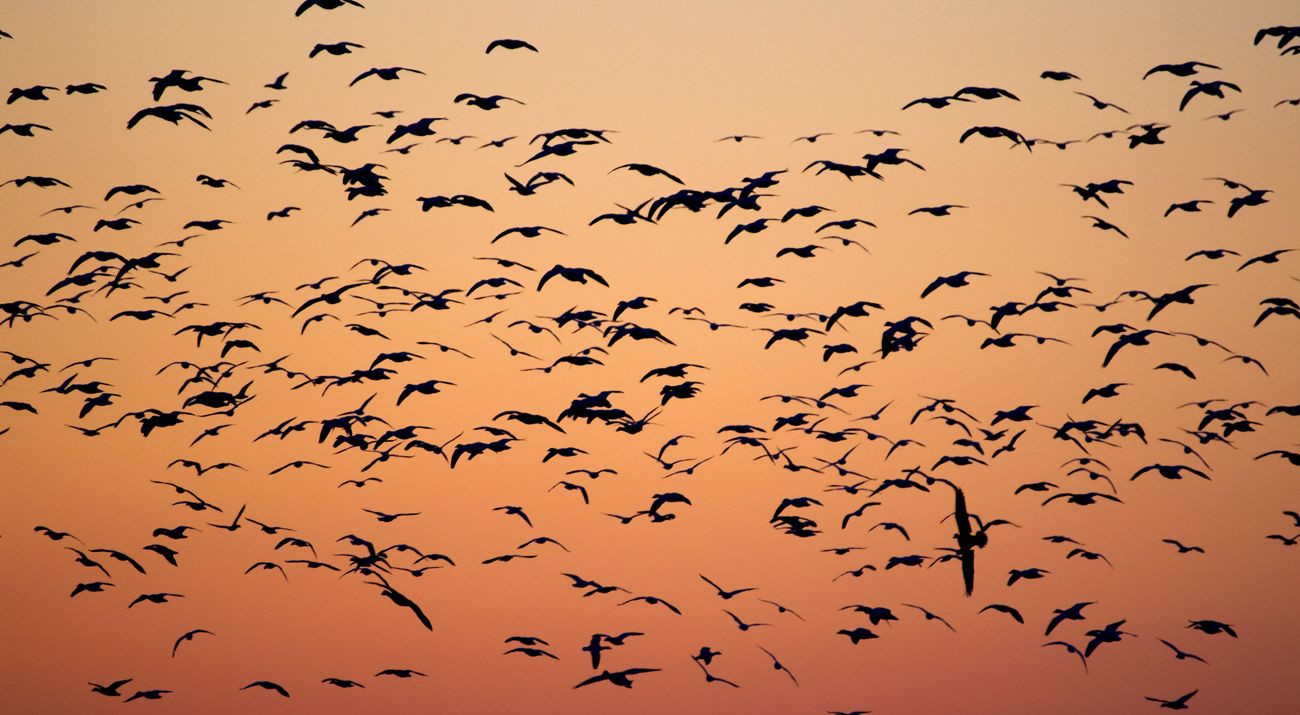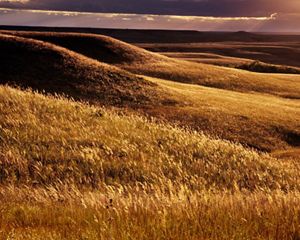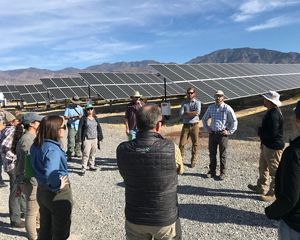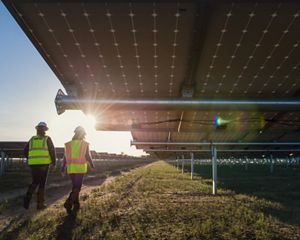Meeting Global Clean Energy Goals Starts Local
How State Officials are Balancing Energy Needs and Wildlife
By Lynn Scarlett, Former Chief External Affairs Officer
The United States has set a new climate target—achieving net zero carbon emissions by 2050. The U.S. setting this pledge, alongside existing commitments from other countries, will help us reduce our vulnerability to climate change.
Accomplishing this net-zero carbon pollution goal will require shifting at least 85% of the world’s energy to non-fossil fuel sources. While this conversion to solar, wind, and geothermal energy will create new technologies and business opportunities (reducing air and water pollution along the way), it could also result in hasty energy development that ends up harming wildlife and natural areas. Fortunately, analysis from The Nature Conservancy suggests there’s more than enough land to develop clean energy while minimizing impacts to nature— if we plan energy development carefully.
To inform how these new energy developments will touch down across the country, over the last two years The Nature Conservancy partnered with the Association of State Fish and Wildlife Agencies to survey wildlife professionals around the country, and gather their insights into how to balance wildlife conservation with the transition to clean energy.
In a new article published in The Wildlife Professional, the national journal for state wildlife professionals, several leaders from state wildlife agencies in Colorado, Kansas, Oregon, and Texas share their recommendations for how to collaboratively address the concerns identified in the survey.
The Nature Conservancy’s Lynn Scarlett, Chief External Affairs Officer, asked co-author Brad Loveless, Secretary of the Kansas Department of Wildlife, Parks and Tourism, about his big takeaways from the project and how he sees these issues touching down in his own state.

Lynn: Hi Brad—how many state fish and wildlife agencies participated in this study, and what did they say that resonated most with you?
Brad: One of the neat things about the study was the high representation we got. We had responses from 39 state agencies, representing about 93% of the total megawatts of wind capacity currently installed, under construction, or in advanced stages of development in the U.S. So we really felt terrific about getting good representation from the state wildlife agencies that are most familiar with wind development.
Lynn: What were some of the findings that resonated the most with you?

Brad: Well, some messages were pretty clear. State wildlife agencies felt like some renewable energy developers really are reaching out early to consult with states to make the best decisions possible in the early stages. But there were also a lot of concerns voiced by wildlife professionals that the kind of early consultation envisioned by the U.S. Fish and Wildlife Service’s Land-Based Wind Energy Guidelines is not happening, or not happening consistently enough. The feeling is sometimes developers contract with landowners without gathering information from the state, which leaves little opportunity to amend projects early in the process to avoid or reduce impacts to sensitive wildlife and habitat. So, if changes do need to be made, they are happening late in the process, which is very costly, difficult, and can be contentious.
Lynn: Net-zero by 2050 is a national goal for the U.S. – but the site development process is often shaped at the state level. What are some of the best practices the Association of Fish and Wildlife Agencies see as important in supporting climate and conservation goals?
Brad: Early planning at a scale larger than individual projects is really important. Conversations with developers about sensitive habitat should not be happening after sites are already selected.
It’s clear there is going to be a huge amount of wind development. We should be looking for ways to incentivize putting renewable projects and transmission lines in places that aren't going to impact wildlife.
This involves some pre-planning, and, frankly, some investment. That takes a little more organization, more coordination among different, often competing wind developers, which can be hard to do. But we really think that would be a huge benefit, and end up saving time and money, and our important natural areas.

Lynn: Are you having discussions with the wind energy sector along those lines? And do you have any sense of the traction that that kind of concept is getting with some of those? I'd be real interested in how the sector is responding.
Brad: Yeah. You know, we’ve had conversations with members of the wind development sector and groups like the American Wind & Wildlife Institute. But conversations with companies that are in competition with each other, as you could expect, is not a simple thing.
Recently we started talking with the U.S. Department of Energy. With their extensive technical capacity, they could really help facilitate the kind of early energy planning and forward-facing, long-range plans we need.
In the interim, it’s a lot to expect individual developers to lead the way on better siting practices, so right now we try to work hand in hand with them, along with the Department of the Interior, and hopefully come up with some long-term, more holistic solutions.
I came out of the industry sector. I worked for a utility for most of my career, and I know that keeping costs low is a big motivator. But our wildlife, waters, and natural areas have tremendous value and should be taken into consideration. If they’re lost, it’s very expensive to try and get these resources back.
As a consumer, when I buy wind energy, I would want to know that it is “green.” Renewable energy projects are not “green” if they are sited in a place that has bad impacts on wildlife. I don't want to get off cheap at the expense of the wildlife.
Quote: Brad Loveless
I don’t want to get off cheap at the expense of the wildlife.
Lynn: Thanks. I really appreciate that sort of big picture look, one of the things that the Conservancy strives to inject into these conversations about climate is that we've got to look big picture at climate and biodiversity together. We don't want to solve one problem and create another as we move along.
So Kansas, of course, is home to some of the last remaining tallgrass prairie in the U.S., and impacts to those habitats and sensitive species, like lesser prairie chicken, are not often not currently regulated. So how can one incentivize renewable energy development to avoid those lands where sensitive species are in the absence of a regulatory mechanism?
Brad: It's difficult because states typically don't have the regulatory authority to step in and say, ‘No, you can't develop there because that’s sensitive habitat.’
Fred Rogers has a great quote. He said, “If it's mentionable, it's manageable.” So often we don't mention concerns about wildlife, legacy agricultural lands, or viewscapes. Let's get that out on the table and discuss it.
The paper we wrote mentions providing offsets for impacts to wildlife and habitat. We want this option to be a last resort. It’s expensive and it's complex. We’d much rather avoid impacts to these lands altogether. We need to have a little bit of humility when it comes to these landscapes that are so sensitive.
We have huge amounts of developed agricultural ground in Kansas where we can integrate some wind development. To me, that's the prettiest sight you could ever see – a wind farm surrounded by wheat, right? The wheat's happy. The wind turbines are happy. Wildlife is happy. Everyone wins.
If we can have more of that, as opposed to putting large, industrial development in Kansas’s iconic places, like the Flint Hills, the Red Hills, and Smoky Hills, then I think we’re all going to be happier with the end result.

Lynn: Why is it so important to get this right, now?
Brad: Well, because this window is closing. In Kansas, we've got important natural habitat and sensitive species such as the Lesser prairie chicken, and tremendous demand for significant amounts of renewable energy. Other states have their own sensitive species we need to be mindful of. It's critically important we get it right now, because once these projects go in, they’re in for 20, 30, 40 years and some of the impacts are permanent.
I have a friend who had a small section of his land tested for oil 20 years ago. They sunk test drills in an area where Lesser prairie chickens would gather during the mating season, called a “lek.” This lek had been there for 100 years, ever since his family settled the land. In the end, there wasn’t enough oil there to set up an operation. But just that test drilling, at the wrong place, at the wrong time, drove those Lesser prairie chickens off the land for decades. And they are only now just starting to come back.
So we need to be smart about where we put our energy, because we are making decisions our kids and grandkids will have to live with.
Site Wind Right
Site Wind Right is an interactive map to help inform siting decisions across 17 US states.
Explore Site Wind RightLynn: The Nature Conservancy has developed tools, such as Site Wind Right, to support low-impact wind development. Do you think resources like these can help avoid conflicts?
Brad: Good science and tools are essential to helping us make good decisions. Having these kinds of tools available so everyone can dive in and see the same information is crucial to getting everyone on the same page, and to agreement.
Lynn: So in listening to you, what gives you hope that the U.S. can sustain wildlife and achieve net zero carbon emissions goals?
Brad: What gives me hope, Lynn, is that we're having this dialogue. The American Wind & Wildlife Institute invited me to be on their board, and I'll tell you, we've had a bunch of challenging, collegial conversations.
But being on the board leads to honest, open dialogue, which indicates to me people want the process to improve. They want to learn. They want to collaborate. They are not putting their heads in the sand and saying ‘No, we want to make our profits now, we'll worry about the sensitive of species later.’
Lynn: That’s great. Well, it’s great to see some encouragement in some hope as we think about these challenges. So I want to wrap up, but I can’t let you go without asking you: what’s your favorite spot in Kansas to enjoy the diversity of the state’s wildlife?
Brad: Such an unfair question!
Kansas is a state of many landscapes from the grasslands that you mentioned, which are just inspiring. Somebody once said, ‘The mountains take your breath away, and the prairies give it back.’
You spend time out on these beautiful, rolling landscapes of Kansas, and you are just struck by the magnitude and the beauty of these grasslands.
Just yesterday I was out in a native pasture, with the butterfly milkweed blooming and they were covered with butterflies, all making use of the beautiful orange blossoms. It's fresh in my mind and in my heart, it was just a gorgeous spot.
Lynn: Absolutely fantastic. Well, I'm a birder. And so, of course, the grasslands of Kansas are legendary for grassland birds, and the textures and differences from place to place are really inspiring, too. Sometimes we think, ‘Oh, there's just all that grass that's uniform’, but it's so different from place to place. So just to wrap up, any final thoughts you want to share in terms of this sort of wind energy, wildlife, climate intersection? Any final thoughts?
Brad: I guess my final thought is getting renewable energy siting right takes a big vision. We have this one opportunity to put wind development in the right place, to really be thoughtful, about how we plan this for our kids, grandkids, and on into the future.
There's never been a better time than now to have these discussions, to step back and challenge ourselves to find solutions for renewable energy develop that are effective, efficient, and have benefits for decades to come.
So that includes the right technology, in the right place, for the good of our whole society-- including for those things that fly, crawl, swim, and hop.
Lynn: Great vision, it’s one that The Nature Conservancy shares with you, so that green is green with all of its many dimensions. Brad, I really appreciate you taking the time to do this interview, and your continued engagement in Kansas and across the country!
Brad: Yes, thank you, this has been a real pleasure. I have appreciated The Nature Conservancy and its work for years and years, and I continue to work with you on a weekly basis. You’re a great partner for us in taking care of the environment.
Global Insights
Check out our latest thinking and real-world solutions to some of the most complex challenges facing people and the planet today.



